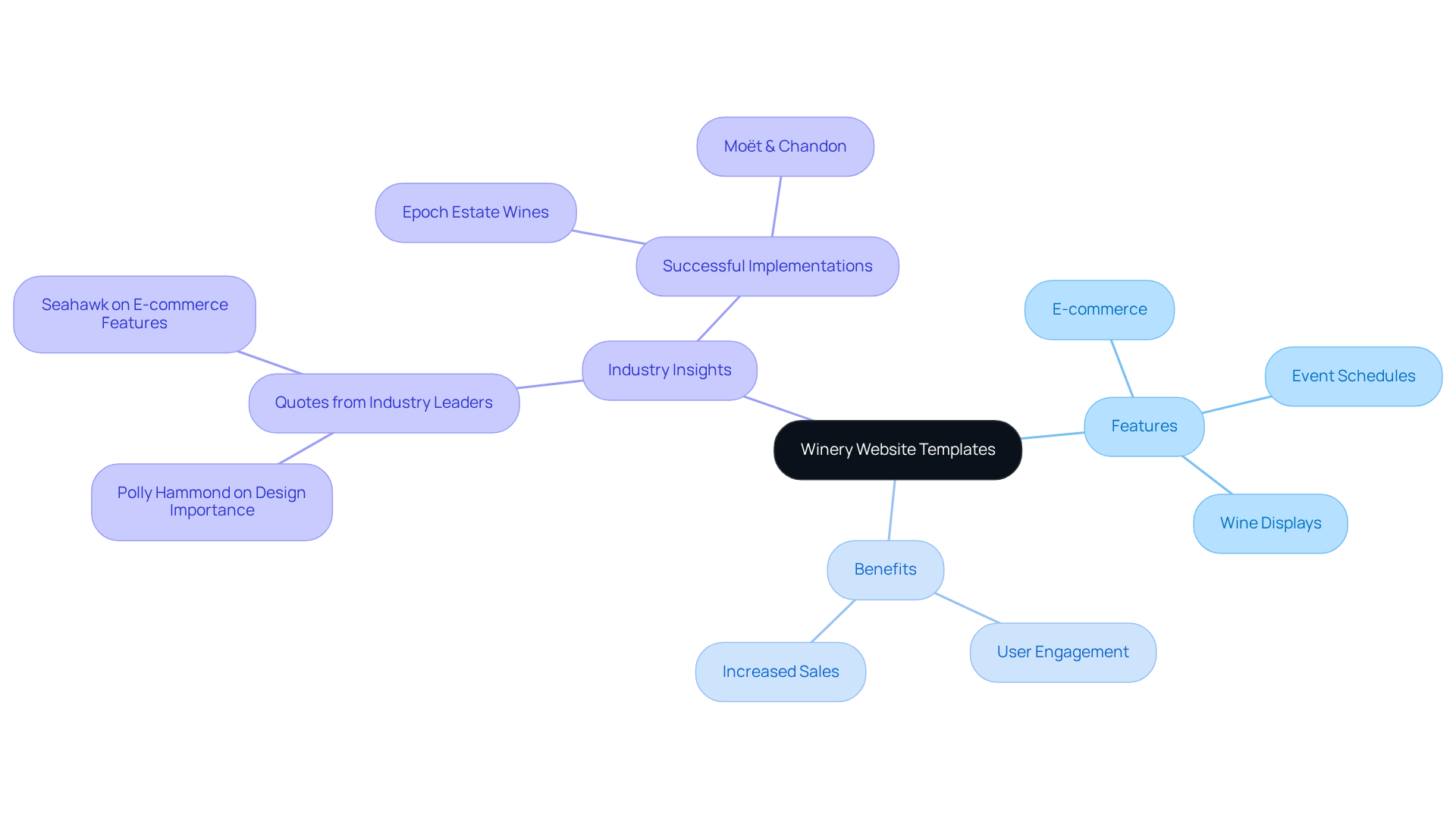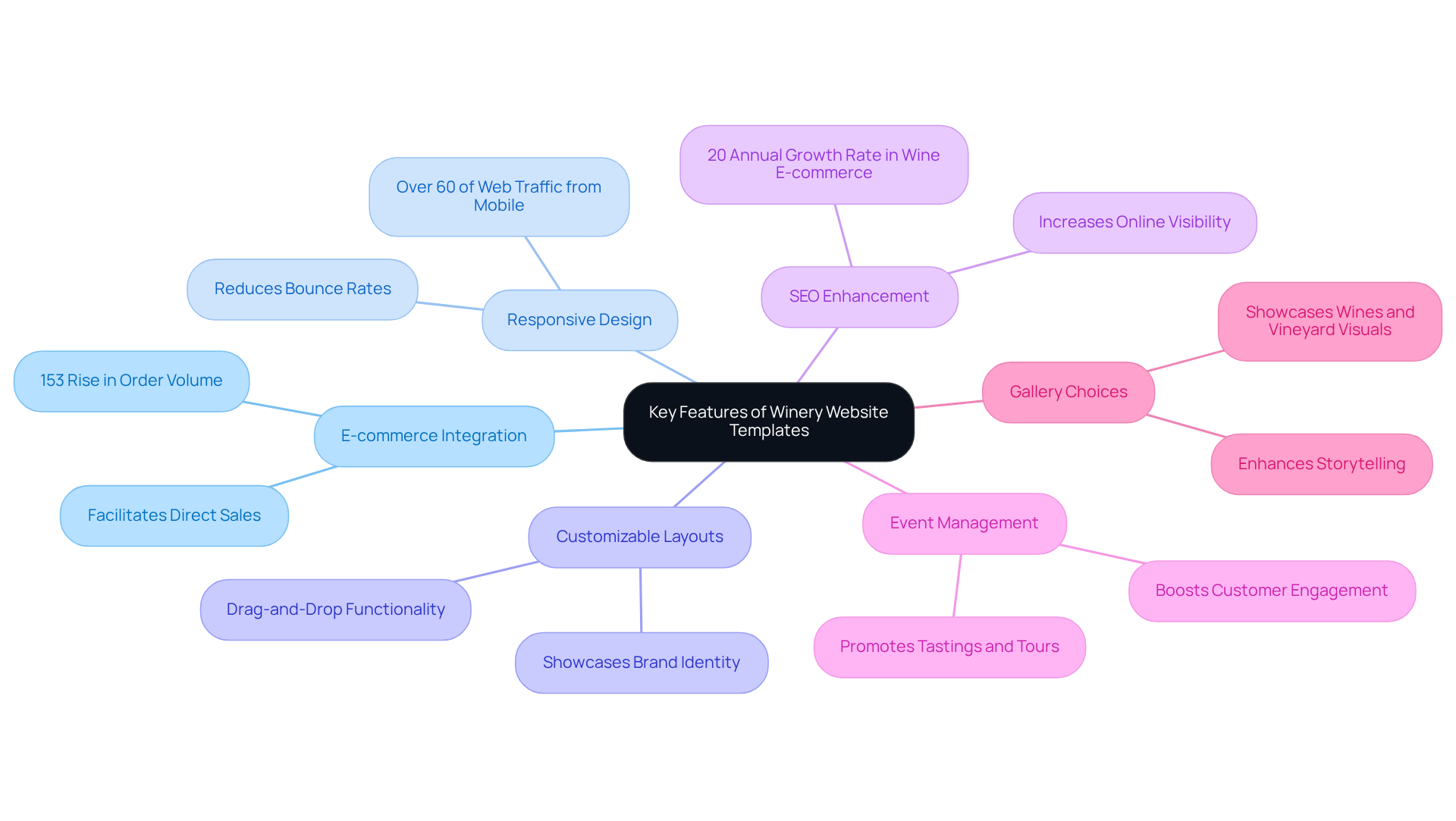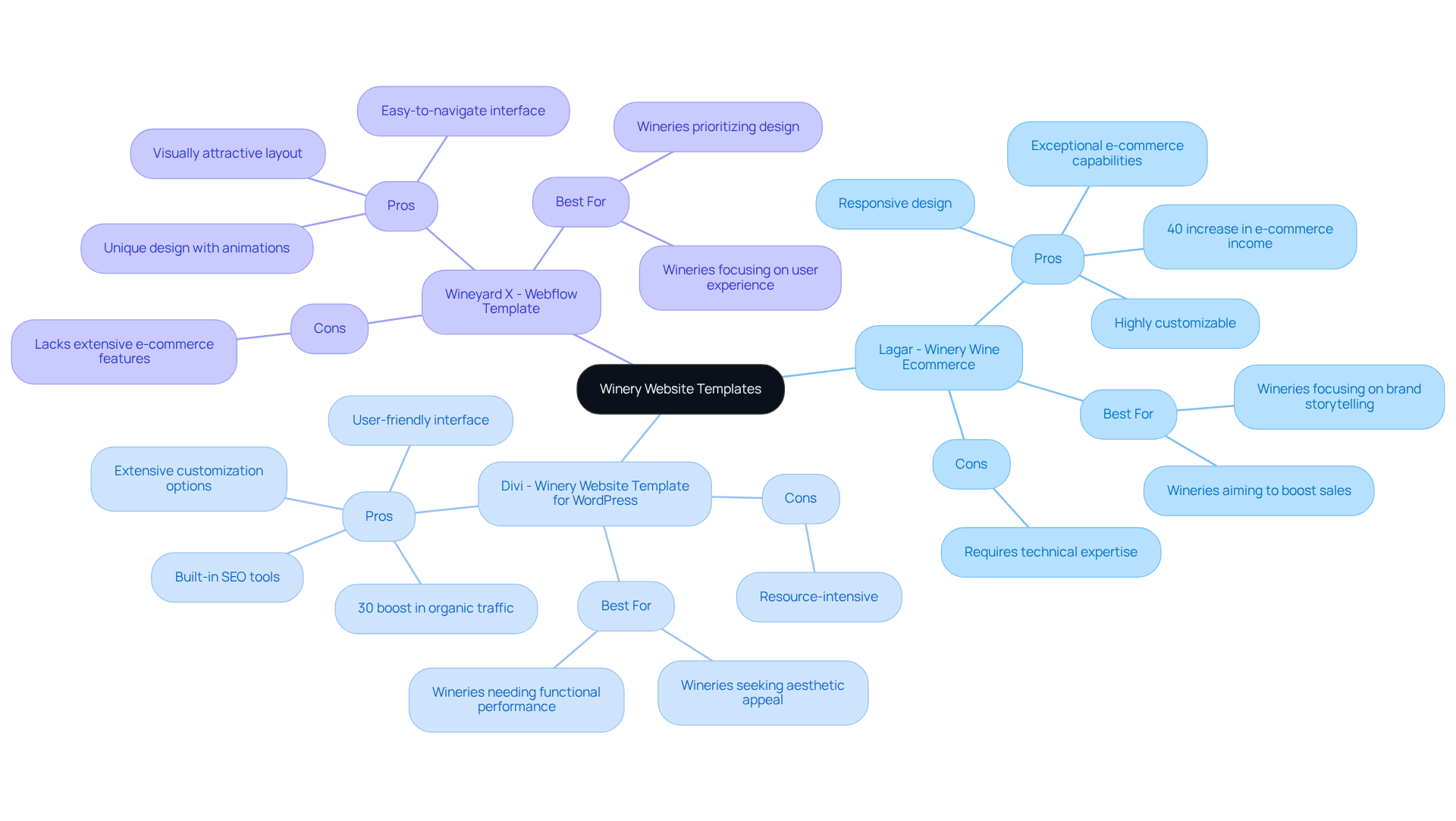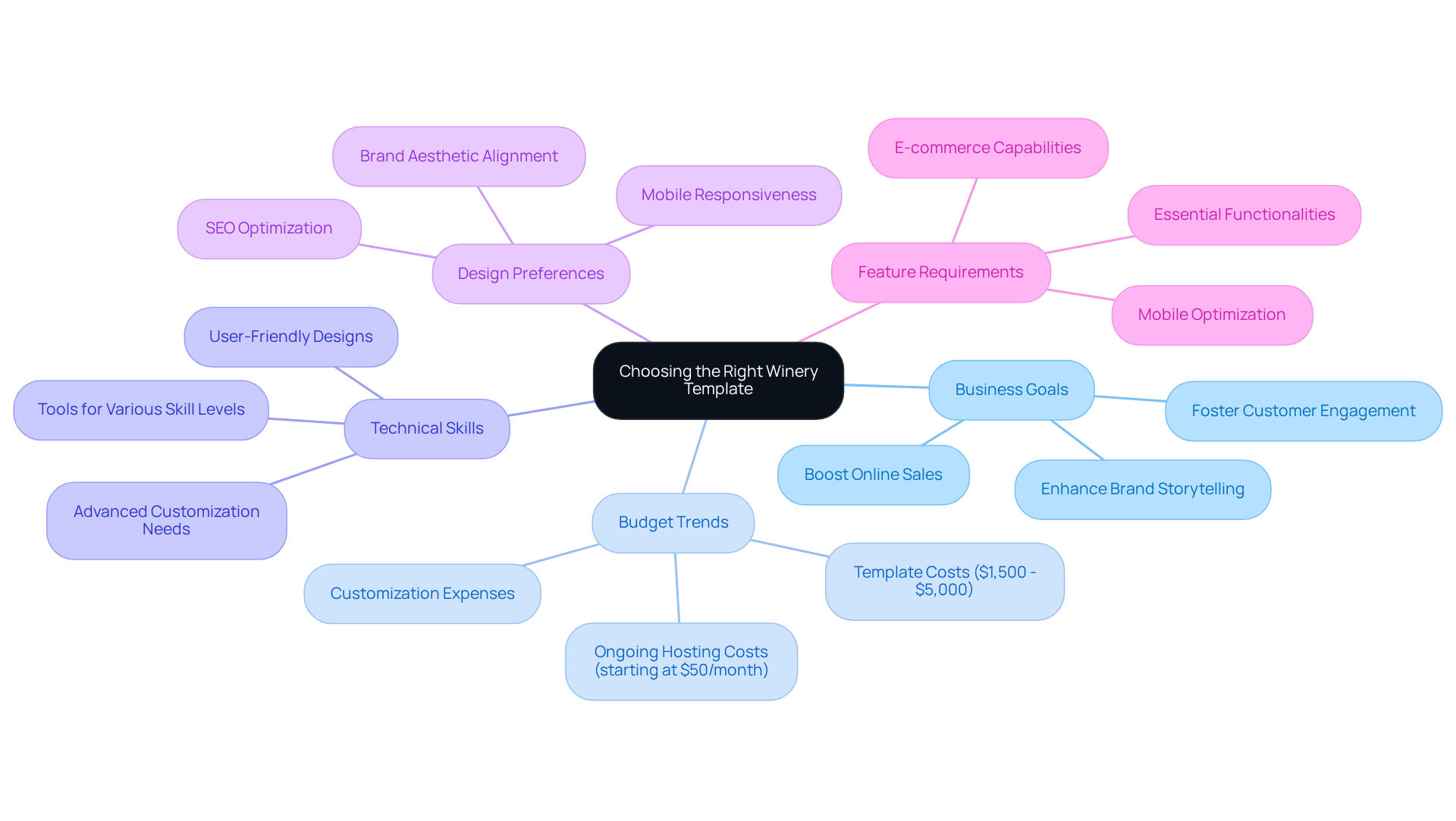Overview
This article provides a comprehensive comparison of winery website templates, highlighting key features and insights that can significantly enhance a vineyard's online presence. It asserts that essential elements such as e-commerce integration, responsive design, and SEO capabilities are vital for driving sales and fostering customer engagement. By demonstrating how effective website templates can transform a winery's digital strategy and strengthen customer connections, this overview emphasizes the necessity for decision-makers in the wine industry to consider these factors. Ultimately, the right website template is not just a choice; it is a strategic investment in the future of a vineyard's online success.
Introduction
Website templates tailored specifically for wineries have become indispensable tools for establishing a compelling online presence. These templates not only streamline the process of creating a digital storefront but also incorporate essential features such as e-commerce integration, event management, and responsive design—elements crucial for engaging today’s tech-savvy consumers.
With a plethora of options available, how can wineries ensure they select the right template that aligns with their unique brand identity and business objectives? This article explores the key features of popular winery website templates, offering insights that will empower vineyard owners to navigate their choices effectively and enhance their direct-to-consumer strategies.
Understanding Winery Website Templates
Website designs, such as winery website templates, serve as pre-created layouts specifically tailored for vineyards, enabling them to effectively establish their online presence. These designs encompass essential features such as e-commerce functionalities, event schedules, and wine displays, making them vital resources for modern wine producers. With a focus on user-friendliness, they empower vineyard owners to customize content without requiring extensive technical skills. By leveraging these frameworks, vineyards can swiftly launch polished online platforms that authentically reflect their brand essence and connect efficiently with customers.
Data indicates that establishments utilizing enhanced site designs experience significant benefits, including improved user engagement and increased digital sales. For instance, e-commerce wine sales are surging, as consumers increasingly prefer home delivery options and subscription models like wine clubs. This trend highlights the necessity for wineries to cultivate a that not only drives sales but also supports strategic capital planning for sustainable growth.
Industry leaders underscore the importance of accessible online design layouts. Polly Hammond, a prominent figure in the wine sector, notes that a well-crafted online platform is crucial for creating an immersive brand experience. The complexity of winery website templates varies, from straightforward HTML designs to advanced WordPress themes, catering to diverse needs and budgets. Successful implementations of these models demonstrate that vineyards can enhance their visibility and customer interaction, ultimately driving sales and fostering loyalty.
In conclusion, vineyard site frameworks act as essential tools for crafting an engaging digital presence, allowing wineries to connect effectively with customers while adapting to the evolving digital landscape and refining their direct-to-consumer strategies.

Key Features of Winery Website Templates
Essential aspects of winery website templates are vital for enhancing digital presence and driving sales. Among these, e-commerce integration stands out as crucial for vineyards aiming to sell products directly online, facilitating seamless transactions that cater to the growing demand for online shopping. Indeed, establishments that have adopted e-commerce strategies have experienced a remarkable 153% rise in order volume during market expansions, underscoring the impact of this integration on sales and its role in generating predictable DTC revenue.
Responsive design is another critical feature, ensuring that websites perform optimally across all devices, from desktops to smartphones. This adaptability is essential, as over 60% of web traffic originates from mobile devices. Implementing responsive design can lead to a significant reduction in bounce rates and a 153% increase in e-commerce order volume, enhancing user engagement and satisfaction—key factors in transforming casual buyers into loyal club members.
Furthermore, numerous templates provide customizable layouts with drag-and-drop functionality, empowering businesses to adapt their sites to showcase their distinct brand identities. This personalization fosters a deeper connection with consumers, which is vital in a competitive market. Research indicates that businesses that effectively customize their digital presence can see substantial improvements in user engagement and conversion rates, further supporting the growth of sustainable direct-to-consumer channels.
SEO enhancement features are also paramount, assisting vineyards in increasing their visibility on search engines and attracting more visitors. With the average annual growth rate of wine e-commerce in the U.S. around 20%, can significantly elevate a vineyard's online presence, driving more traffic and potential sales, which is crucial for long-term success.
Moreover, event management capabilities enable vineyards to promote tastings and tours directly on their websites, driving foot traffic and enhancing customer engagement. By effectively managing events, vineyards can boost participation, resulting in increased sales and customer loyalty—essential for family-owned establishments aiming to prosper for generations.
Ultimately, gallery choices allow vineyards to display their wines and vineyard visuals, crafting an attractive visual experience that captivates visitors. By showcasing high-quality images and engaging content, vineyards can enhance their storytelling and connect more effectively with their audience, reinforcing their brand narrative and supporting strategic capital planning.
Collectively, these features empower producers to connect with consumers more effectively and drive sales, making them indispensable in today's digital landscape.

Comparative Analysis of Popular Winery Website Templates
In this comparative analysis, we delve into three prominent winery website templates, each tailored to distinct needs and preferences, all while enhancing direct-to-consumer strategies and brand storytelling:
-
Lagar - Winery Wine Ecommerce:
- Pros: Highly customizable, exceptional e-commerce capabilities, and a responsive design that adapts seamlessly to various devices. Vineyards utilizing the Lagar model have noted a considerable rise in digital sales, with some achieving as much as a 40% increase in e-commerce income during the initial year of execution. This template is particularly effective for wineries aiming to transform casual buyers into loyal club members through compelling storytelling and engaging user experiences.
- Cons: Users may require some technical expertise to fully leverage its customization options.
- Best For: Wineries aspiring to boost sales through the internet with the help of winery website templates while effectively conveying their brand narrative.
-
Divi - Winery Website Template for WordPress:
- Pros: Features a user-friendly interface, extensive customization options, and built-in SEO tools to enhance online visibility. Wineries employing Divi have observed improved search engine standings, with some experiencing a 30% boost in organic traffic after refining their sites with this design. This aligns with strategic capital planning, as increased visibility can lead to improved customer acquisition and retention.
- Cons: Can be resource-intensive, potentially leading to slower site performance if not properly optimized.
- Best For: Wineries seeking a harmonious blend of aesthetic appeal and functional performance in winery website templates.
-
Wineyard X - Webflow Template:
- Pros: Offers a unique design with seamless animations and an easy-to-navigate interface. This design has been praised for its visually attractive layout, which enhances user engagement and prolongs duration on the site. By prioritizing design and user experience, vineyards can effectively communicate their brand story and values, fostering a deeper connection with potential customers.
- Cons: Lacks the extensive e-commerce features found in other designs.
- Best For: Wineries that prioritize in winery website templates over comprehensive e-commerce functionalities.
This examination highlights the strengths and weaknesses of each model, assisting vineyards in selecting the most suitable option for their operational requirements and marketing approaches. Furthermore, integrating efficient digital marketing strategies, such as SEO and content marketing, can further enhance the performance of these designs, attracting traffic and converting visitors into loyal customers. A well-crafted vineyard online presence should also emphasize accessibility to reach a broader audience, ensuring that all prospective clients can interact with the brand effectively.

Choosing the Right Template for Your Winery's Needs
When selecting the ideal winery website template, it is essential to consider several critical factors:
- Business Goals: Clearly articulating your primary objectives is paramount—whether your aim is to boost online sales, enhance brand storytelling, or foster customer engagement. Each objective will influence your design selection. Aligning your website design with direct-to-consumer strategies can transform casual buyers into loyal club members, thereby driving sustainable growth.
- Budget Trends: Establish a budget that encompasses both design costs and potential customization expenses. Templates typically range from $1,500 to $5,000, making it crucial to understand your . Additionally, factor in ongoing hosting and management plans starting at $50 per month, which can significantly impact your overall budget. Strategic capital planning is vital for effectively allocating resources for these investments.
- Technical Skills: Assess your team's technical expertise. While some designs are user-friendly, others may necessitate advanced skills for customization and maintenance. For instance, tools such as Wine Maker provide over 150 shortcode elements, making them accessible to users with varying technical abilities. Ensuring your team can effectively manage the online platform is crucial for successfully implementing direct-to-consumer strategies.
- Design Preferences: Select a layout that resonates with your brand's aesthetic and values. A visually appealing platform can greatly enhance consumer perception and engagement. Ensure that the layout is mobile-responsive and optimized for search engines, as over half of global online traffic originates from mobile devices. Crafting captivating brand narratives through your design can significantly enhance visitor engagement and foster loyalty.
- Feature Requirements: Prioritize essential functionalities such as e-commerce capabilities, mobile responsiveness, and SEO optimization. For example, the Yummix layout is specifically designed to enhance the online visibility of wine bars and eateries, underscoring the importance of selecting a design that meets particular business needs. Customizing your online platform features to support strategic capital opportunities can unlock substantial growth potential.
By meticulously evaluating these factors, wineries can select winery website templates that not only meet their immediate needs but also lay a foundation for sustainable growth and deeper customer connections. Aligning website design with business goals and direct-to-consumer strategies is essential for maximizing the effectiveness of your online presence.

Conclusion
In the realm of online marketing, winery website templates stand out as essential tools for vineyards aiming to establish a formidable digital presence. These templates not only offer tailored designs but also integrate crucial features such as e-commerce capabilities, responsive layouts, and SEO optimization. This empowers wineries to forge connections with consumers and elevate their brand storytelling. The capacity to customize content without requiring extensive technical skills enables vineyard owners to launch professional websites that resonate with their target audience, ultimately driving sales and fostering customer loyalty.
The discussion highlights the significant advantages of utilizing winery website templates. From the surge in e-commerce sales to the necessity of responsive design in today’s mobile-centric world, the insights gathered emphasize the importance of selecting the right template to fulfill specific business objectives. A comparative analysis of popular templates, including Lagar, Divi, and Wineyard X, illustrates the diverse options available, each catering to different needs and preferences while promoting effective direct-to-consumer strategies.
As wineries navigate the evolving digital landscape, prioritizing the selection of an appropriate website template that aligns with their objectives and budget becomes increasingly essential. By considering factors such as technical skills, design preferences, and feature requirements, vineyard owners can make informed decisions that not only enhance their online visibility but also support sustainable growth. Investing in the right winery website template transcends mere design choice; it represents a strategic move toward cultivating lasting connections with consumers and ensuring long-term success in the competitive wine industry.
Frequently Asked Questions
What are winery website templates?
Winery website templates are pre-created layouts specifically designed for vineyards to establish their online presence. They include essential features like e-commerce functionalities, event schedules, and wine displays.
How do winery website templates benefit vineyard owners?
These templates empower vineyard owners to customize their content without needing extensive technical skills, allowing for a swift launch of polished online platforms that reflect their brand and connect with customers.
What advantages do wineries experience by using enhanced website designs?
Wineries that utilize enhanced site designs see improved user engagement and increased digital sales, particularly as e-commerce wine sales grow due to consumer preferences for home delivery and subscription models.
Why is having a strong online presence important for wineries?
A robust online presence is crucial for driving sales and supporting strategic capital planning for sustainable growth, especially in the context of rising e-commerce trends.
What does Polly Hammond emphasize about winery website design?
Polly Hammond highlights that a well-crafted online platform is essential for creating an immersive brand experience in the wine sector.
What types of winery website templates are available?
Winery website templates vary in complexity, ranging from straightforward HTML designs to advanced WordPress themes, catering to different needs and budgets.
How do winery website templates enhance visibility and customer interaction?
Successful implementations of winery website templates allow vineyards to enhance their visibility and customer interaction, which can ultimately drive sales and foster customer loyalty.
What role do winery website templates play in direct-to-consumer strategies?
Vineyard site frameworks serve as essential tools for creating an engaging digital presence, enabling wineries to effectively connect with customers while adapting to the evolving digital landscape.




